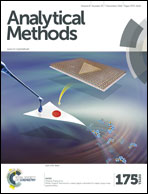Highly sensitive and selective detection of perfluorooctane sulfonate based on the Janus Green B resonance light scattering method†
Abstract
A simple, highly sensitive and selective assay method has been developed for the determination of perfluorooctane sulfonate (PFOS), a kind of emerging persistent organic pollutant, which is bio-accumulative, resistant to degradation and toxic. It was found that PFOS can form complexes with protonated Janus Green B (JGB) through electrostatic interaction in pH 5.8 citric acid–sodium citrate (CA–NaCA) buffer medium resulting in a remarkable enhancement of the resonance light scattering (RLS) intensity of the system. The study shows that the maximum scattering wavelength is located at 319.0 nm and the enhanced RLS intensities are in proportion to the concentration of PFOS in the range of 0.05–9.0 μmol L−1 (R2 = 0.9958), with a detection limit of 5.6 nmol L−1 (3σ). Under the same experimental conditions, various perfluorinated compounds (PFPrA, PFBA, PFPeA, PFHeA, PFHpA, PFOA, PFNA, and PFBS) and JGB interactions were studied and the scattering signal changes very little. Based on the above discussion, a simple, highly sensitive and selective resonance light scattering analysis method was established for the detection of PFOS. In this work, the optimum reaction conditions were investigated. The reaction mechanism between JGB and PFOS was also studied by the absorption spectrum, scanning electron microscopy (SEM), the combination ratio and so on. This method is successfully applied to the selective detection of PFOS in environmental water samples with RSD ≤2.7%.


 Please wait while we load your content...
Please wait while we load your content...